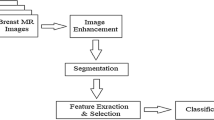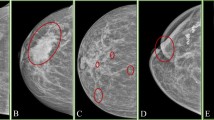Abstract
Breast cancer is the most widely disease in women and is considered one of the biggest causes of death in women. Early detection, classification, and diagnosis of this cancer are essential to reduce the death cases. The efficiency of the diagnosis of breast cancer depends on the accuracy of the segmentation of the tumor and its classification. Before the segmentation of mammogram images, it is necessary to extract the Region of Interest (ROI) because it can assume a significant job in the efficiency of tumor detection. In this study, the method of automatic extraction of ROI from the mammogram image is presented. After that, the preprocessing of both mammogram and MR images has been done which removes the noise and enhances the contrast of the images. On the processed images, segmentation of tumors from mammograms as well as Magnetic Resonance Imaging (MRI) breast images has been performed using automatic seed point extraction and threshold calculation in Seeded Region Growing (SRG). After the successful detection of breast tumor area, classification of the tumor as benign or malignant has been done. The test was performed on three publicly available data sets; RIDER breast MR Images, Mammographic Image Analysis Society (MIAS), and Digital Database for Screening Mammography (DDSM). The test showed that classification accuracy is better than previously accessible cutting edge techniques, which is 91.4%. The proposed method not only detects the shape and size of the tumor from both mammograms and MR Images but also efficiently classifies the tumor as benign or malignant.










Similar content being viewed by others
References
American Cancer Society, “Cancer Facts & Figures 2020” Available at: https://www.cancer.org/content/dam/cancer-org/research/cancer-facts-and-statistics/annual-cancer-facts-and figures/2020/cancer-facts-and-figures-2020.pdf [access on 28 March, 2020].
Huang G, Zhou H, Ding X, Zhang R (2012) Extreme Learning Machine for Regression and Multiclass Classification. IEEE Transaction Syst. Man Cyber, Part B: Cybern 42(2):513–529
Chu J, Min H, Liu L, Lu W (2015) A novel computer aided breast mass detection scheme based on morphological enhancement and SLIC super pixel segmentation. Med Phys 42(7):3859–3869
Gallego-Ortiz C, Martel AL (2015) Improving the accuracy of computer-aided diagnosis for breast MR imaging by differentiating between mass and non-mass lesions. Radiology 278(3):679–688
Wang H, Feng J, Bu Q, Liu F, Zhang M, Ren Y and Lv Y “Breast mass detection in digital mammogram based on gestalt psychology”, Hindwai Journal of Healthcare Engineering, Vol. 2018, pp 1–13.
Shah NN, Ratanpara TV, Bhensdadia CK (2014) Early Breast Cancer Tumor Detection on Mammogram Images. International Journal of Computer Applications 87:114–120
Badawy SM, Hefnawy AA, Zidan HE, GAdallah MT (2017) Breast Cancer Detection with Mammogram Segmentation: A Qualitative Study. International Journal of Advanced Computer Science and Applications 8(10):117–120
Dhungel N, Carneiro G, Bradley AP (2017) A deep learning approach for the analysis of masses in mammograms with minimal user intervention. Med Image Anal 37:114–128
Ragab DA, Marshall MSS, Ren J (2019) Breast Cancer Detection using Deep Convolutional Neural Networks and Support Vector Machines. PeerJ 7:1–23
Kim H, Kim HH, Han B, Kim KH, Han K, Nam H, Lee EH, Kim E (March 2020) Changes in Cancer detection and false positive recall in mammography using artificial intelligence: a retrospective multi-reader study. Lancet Digital Health 2:38–48
Adams R, Bischof L (1994) Seeded Region Growing. IEEE Transactions on Pattern Analysis and Machine Intelligence 16(6):641–647
Melouah A, Layachi S (2015) “A novel automatic seed placement approach for region growing segmentation in mammograms”, presented at IPAC’15 Batna Algeria. November 23-25:1–5
Saleek MM and Moutaouakki AME (2018) “Automatic Seed Region Growing Based on Texture Features for Mass Segmentation in digital Mammography” presented at International Conference on Information Technology and Communication Systems, Advances in intelligent systems and computing Vol. 640 Springer International Publishing AG, pp 331–338
Suckling J, Parker J, Dance D, Astley S, Hutt I, Boggis C and Ricketts, “Mammographic Image Analysis Society (MIAS) database v1.21 [Dataset] 2015”.https://www.repository.cam.ac.uk/handle/1810/250394.
Heath M, Bowyer K, Kopans D, Moore R and Philip Kegelmeyer W (2001) “The Digital Database for Screening Mammography”, presented at Proceedings of the Fifth International Workshop on Digital Mammography, Medical Physics Publishing, pp 212–218 https://doi.org/10.1148/radiol.2291032535
https://wiki.cancerimagingarchive.net/display/Public/RIDER+Breast+MRI [accessed on 22-04-2016].
Clark K, Vendt B, Smith K, Freymann J, Kirby J, Koppel P, Moore S, Phillips S, Maffitt D, Pringle M, Tarbox L, Prior F (2013) The Cancer imaging archive (TCIA): maintaining and operating a public information repository. J Digit Imaging 26(6):1045–1057
Shrivastava N and Bharti J (2020) “Breast tumor detection in digital mammogram based on efficient seeded region growing segmentation”, IETE Journal of Research
Petitjean C, Dacher J (2011) A Review of Segmentation Methods in Short Axis Cardiac MR Image. Medical Image Analysis 15(2):169–184
Wang J, Yang Y (2018) A context sensitive deep learning approach for micro calcification detection in mammograms. Pattern Recogn 78:12–22
Wang Z, Qu Q, Yu G, Kang Y (2014) Breast tumor detection in double views mammography based on extreme learning machine. Neural Computing & Application 27:227–240
Comelli A, Brano A, Laura Di Vittorio M, Ienzi F, Lagalla R, Vitabile S, Ardizzone E (2017) “Automatic multi-seed detection for MR breast image segmentation”, presented at international conference on image analysis and processing. Catania Italy, Sep 11-15:706–717
A. Qusay A. Faris, U. Kalthum Ngah, Isa NAM and Shuaib IL (2008) “Breast MRI Tumor Segmentation using Modified Automatic Seeded Region Growing Based on Particle Swarm Optimization Image Clustering”, presented at Soft Computing in Industrial Applications, Springer, Cham, 2014, pp 49–60. Images”, presented at International Conference on Pattern Rocognition, Tampa, FL, USA, IEEE, Dec 8–11, pp 1–4
Shrivastava N, Bharti J (2016) Empirical analysis of image segmentation techniques. Presented at Smart Trends in Information Technology and Computer Communications, Jaipur, India, August 6-7:143–150
Shrivastava N, Bharti J (2018) “A comparative analysis of medical image segmentation”, presented at international conference on advanced computing networking and informatics. Advances in Intelligent Systems and Computing, Indore, India, February 22-24:459–467
Shao H, Min Xian YZ, Cheng HD, Xu F and Ding J, “A Sailency Model for Automated Tumor Detection Model in Breast Ultrasound Images”, presented at IEEE International Conference on Image Processing (ICIP), Quebee City, QC Canada, 10 December, 2015, pp. 1424–1428.
Shrivastava N and Bharti J, “Multi-stage System for Preprocessing Mammograms”, IEIE Transactions on Smart Processing and Computing, Vol. 9, Issue No. 2, April 2020, pp. 119–126.
Maitra IK, Nag S, Bandhyopandhyay SK (2012) Technique for pre-processing of digital mammogram. Comput Methods Prog Biomed 107:175–188
Prabha DS and Kumar JS, “Performance Evaluation of Image Segmentation using Objective Methods”, Indian Journal of Science and Technology, Vol. 9, Issue No. 8, 2016, pp 1–8.
Kalavathi P, “An Image Spatial Alignment Method for Computing Region Overlapping Measures”, International Journal of Emerging Trends & Technology in Computer Science”, Vol. 3, Issue 5, 2014, pp 251–255.
Aqil Burney SM and Tariq H, “K-Means Cluster Analysis for Image Segmentation”, International Journal of Computer Applications, Vol. 96, Issue No. 4, 2014, pp 1–8.
Phophalia A, Mitra SK and Chawla C, “A Study on Image Segmentation using Moments”, Asian Journal of Computer Science and Information Technology, Vol. 2, Issue No. 5, 2012, pp 89–93.
Fu K, Zhao Q, Yu-Hua Gu I, Yang J (2019) Depside: a general deep framework for salient object detection. Neurocomputing 356:69–82
Fan D, Cheng M, Liu Y, Li T and Borji A, “Structure-Measure: A New Way to Evaluate Foreground Maps”, presented at IEEE International Conference on Computer Vision, Venice Italy, 22 Oct 2017 to 27 Oct 2017, pp. 4558–4567.
Fan D, Gong C, Cao Y, Ren B, Cheng M and Borji A, “Enhanced-Alignment Measure for Binary Foreground Map Evaluation”, presented at proceedings of the Twenty Seventh International Joint Conference on Artificial Intelligence (IJCAI-18), pp. 698–704.
Margolin R, Zelnik-Manar L and Tal A, “How to evaluate foreground maps?”, presented at IEEE conference on computer vision and pattern recognition, 24–27 June, 2014, Columbus, Ohio, pp. 1–8.
Vikhe PS and Thool VR, “Mass Detection in Mammographic Images using Wavelet Processing and Adaptive Threshold Technique”, Journal of Medical Systems, Vol. 40, Issue No. 4, 2016, pp 82–90.
Basheer NM and Mohammed MMH, “Segmentation of Breast Masses in Digital Mammograms using Adaptive Median Filtering and Texture Analysis”, International Journal of Recent Technology and Engineering, Vol. 2, Issue No. 1, 2013, pp 39–43.
Yousefikamal P, “Breast Tumor Classification and Segmentation using Convolution Netural Networks”, Computer Vision and Pattern Recogn, 2019, pp. 1–12.
Liu L. Li J, and Wang Y, “Breast Mass Detection with Kernelized Supervised Hashing”, presented at International Conference on Biomedical Engineering and Informatics Shenyang, China, Oct 14–15, 2015, pp 79–84.
Samala R, Chan H, Hadjiiski L, Helvie M, Richter C and Cha K, “Breast Cancer Diagnosis in Digital Breast Tomosynthesis: Effects of Training Sample Size on Mul-Stage Transfer Learning using Deep Neural Nets”, IEEE Trans Med Imaging, Vol. 38, Issue No. 3, 2019, pp 686–696.
Singh VK, Rashwan HA, Romani S, Akram F, Pandey N, Sarkar MK, Saleh A, Arenas M, Arquez M, Puig D, Torrents-Barrena J (2020) Breast Tumor Segmentation and Shape Classification in Mammograms using generative adversarial and Convolutional Neural Netowrk. Expert System with Applications 139(112855):1–14
Ponnusamy J and Babu NK, “Joint Probabilistic Seed Selection based Fuzzy Region Growing Algorithm to Segment Tumour on Breast MRI”, International Journal of Printing Packaging and Allied Sciences, Vol. 21, Issue No. 2, 2016, pp 1428–1437.
Ponnusamy JAR and Babu CNK, “Breast Lesion Segmentation using Generalised Simulated Annealing and Neutrosophic Region Growing Algorithm in Breast MRI”, Academic Journal of Cancer Research, Vol. 9, Issue No 4, 2016, pp 75–81.
N. Mao, P. Yin, Q. Wang, M. Liu, J. Dong, X. Zhang, H. Xie and N. Hong, “Added value of radiomics on mammography for breast cancer diagnosis: a feasibility study,” Journal of the American College of Radiology, vol. 16, Issue no. 4, 2019, pp. 485–491.
Jui-Ying C, Kuan-Yung C, Ying-Kai LK, Po-Hsin H, Geoffrey Z, Tzung-Chi H, Yan L (2019) Detection and classification the breast tumors using mask R-CNN on sonograms. Medicine 98:1–5
Dhungel N, Carneiro G, Bradley AP (2017) A deep learning approach for the analysis of masses in mammograms with minimal user intervention. Med Image Anal 37:114–128
Wang J, Yang Y (2018) A context sensitive deep learning approach for micro calcification detection in mammograms. Pattern Recogn 78:12–22
Zhang J, Yu X, Li A, Song P, Liu B and Dai Y, “Weakly-Supervised Salient Object Detection via Scribble Annotations”, In Proc. IEEE International Conference on Computer Vision, 2020, pp. 1–10.
Zhao J, Liu J, Fan D, Cao Y, Yang J and Ming Cheng M, “Egnet: Edge Guidance Network for Salient Object Detection”, In Proc. IEEE International Conference on Computer Vision, 2019, pp. 1–10.
Fu K, Zhao Q, Yu-Hua Gu I, Yang J (2019) Deepside: a general deep framework for salient object detection. Neurocomputing 356:69–82
Wei J, Wang S and Huang Q, “F3Net: Fusion, Feedback and Focus for Salient Object Detection”, In Proc. AAAI Conference on Artificial Intelligence (AAAI), 2019, pp. 1–18.
Acknowledgements
We would like to thank organizer of Mammographic Image Analysis Society (MIAS), Digital Database for Screening Mammography (DDSM) and RIDER Breast MR Imaging Society for sharing mammograms images with us so that we are able to test the performance of our algorithm.
Author information
Authors and Affiliations
Corresponding author
Ethics declarations
Conflict of interest
The authors would like to inform that no conflicts of interest, financial or others exist.
Additional information
Publisher’s note
Springer Nature remains neutral with regard to jurisdictional claims in published maps and institutional affiliations.
Rights and permissions
About this article
Cite this article
Shrivastava, N., Bharti, J. Breast tumor detection and classification based on density. Multimed Tools Appl 79, 26467–26487 (2020). https://doi.org/10.1007/s11042-020-09220-x
Received:
Revised:
Accepted:
Published:
Issue Date:
DOI: https://doi.org/10.1007/s11042-020-09220-x




